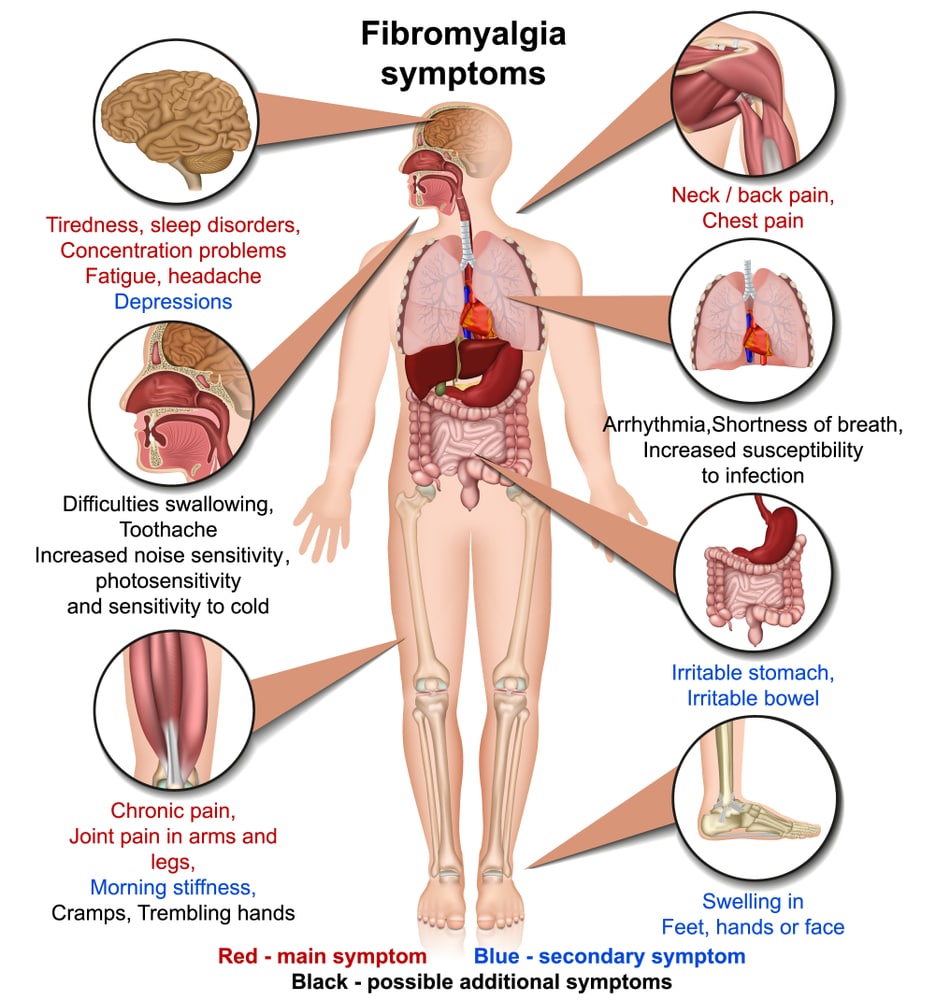Is Fibromyalgia Real? Symptoms, Diagnosis & Treatment
Is Fibromyalgia real or just a thought hitting our brain is the most debatable question for years. The best answer to this is given by one who is living or has seen someone close to surviving it.
Fibromyalgia is a chronic illness that includes fatigue, discomfort, and widespread musculoskeletal pain along with other symptoms like headaches, sleep disruptions, mental disorders like melancholy and anxiety, and cognitive issues (commonly referred to as “fibro fog”).
In this blog post we have attempted to summarise the most burning question on the internet: Is fibromyalgia real or not?
What causes fibromyalgia?
Before we delve into whether is Fibromyalgia real we need to get through what causes Fibromyalgia.
The following are some variables that could lead to the onset of fibromyalgia:
- Genetics: Given that fibromyalgia frequently runs in families, it seems to have a hereditary tendency. Some people may be more prone to the illness due to specific genetic differences.
- Aberrant nervous system processing of pain signals: Fibromyalgia is assumed to be associated with abnormal nervous system processing of pain signals. This may result in increased pain sensitivity (central sensitization) and an excessive reaction to stimuli that wouldn’t typically cause pain.
- Neurochemical imbalances: Variations in the amounts of neurotransmitters, including substance P, dopamine, and serotonin, may contribute to the development of fibromyalgia. These neurotransmitters play a role in mood, sleep, and pain perception regulation.
- Physical trauma or injury: Physical trauma or injury, such as a car accident, surgery, or repetitive stress injuries, can cause fibromyalgia in certain situations.
- Infections: In certain people, certain infections like bacterial or viral infections, can cause or worsen the symptoms of fibromyalgia.
- Psychological aspects: Fibromyalgia symptoms can be made worse by stress, worry, depression, and other psychological problems that affect how pain is perceived.
What are the symptoms of fibromyalgia?

Although millions of people are fighting with Fibromyalgia, the debate on whether Is Fibromyalgia real is a mystery. People often confuse its medical symptoms and continuously try to ignore them rather than seek an approach to fight them.
Some Common signs of fibromyalgia include:
- Persistent and widespread pain.
- Fatigue
- Sleep disorders.
- Trouble focusing
- Memory issues.
- Poor judgment.
- Stiffness
- Headaches
- Increased sensitivity to several stimuli, including light, sound, touch, and temperature.
- Irritable Bowel Syndrome (IBS).
- Bladder issues.
- Paresthesia
- Dizziness
- Mood disorders like anxiety and sadness.
How is fibromyalgia diagnosed?

A lot of research indicates that whether Is Fibromyalgia real remains unclear due to its challenging diagnosis. Since there are no particular laboratory tests or imaging examinations that can conclusively identify the condition, diagnosing fibromyalgia can be difficult. Rather, medical professionals usually use a mix of history taking, physical examination, and symptom evaluation according to predetermined standards.
Fibromyalgia is commonly identified through:
- Medical history: Your doctor will begin by obtaining a thorough medical history, which will include questions about the nature of your symptoms, when they first appeared, and how they have changed over time.
- Physical examination: To check for fibromyalgia symptoms, such as tender spots, tight muscles, and joint pain, your healthcare professional will conduct a physical examination. Your posture, range of motion, and general muscle strength may also be assessed.
- Evaluation of symptoms: The hallmarks of fibromyalgia include diffuse musculoskeletal pain and tenderness, as well as additional symptoms like tiredness, disturbed sleep, and cognitive impairments.
- Diagnostic standards: The presence of tender points at particular anatomical locations and widespread pain that lasts for at least three months are the diagnostic standards for fibromyalgia as set by the American College of Rheumatology (ACR).
- Exclusion of other conditions: Since fibromyalgia is an exclusion diagnosis, it is necessary to rule out other disorders that may present with comparable symptoms to arrive at a diagnosis. To rule out diseases including rheumatoid arthritis, lupus, hypothyroidism, and other autoimmune or inflammatory disorders, your healthcare practitioner may prescribe blood tests, imaging scans, or another diagnostic testing.
Is Fibromyalgia Real?

To answer precisely is Fibromyalgia real, Indeed, fibromyalgia is a real medical condition acknowledged by medical professionals across the globe. It is categorized as a chronic pain condition that is typified by soreness and extensive musculoskeletal pain, along with additional symptoms like exhaustion, disturbed sleep, and cognitive impairments.
Although the precise etiology of fibromyalgia remains unclear, research points to anomalies in the nerve system’s and brain’s processing of pain signals. Although fibromyalgia can significantly lower a person’s quality of life, many of its sufferers can properly manage their symptoms and lead happy, fulfilling lives with the right care and assistance.
Millions of individuals worldwide suffer from fibromyalgia, and its effects go beyond just agony. Fibromyalgia’s persistent pain and exhaustion can seriously interfere with day-to-day activities, employment, interpersonal connections, and general well-being. Because the symptoms of fibromyalgia are frequently invisible to others, those who have the illness frequently struggle to describe it to others.
Each person’s experience with fibromyalgia is different; some may have modest symptoms that may be managed with self-care techniques, while others may suffer from severe pain and exhaustion that severely impairs everyday activities and quality of life.
Fibromyalgia is an unpredictable ailment, and living with it can be difficult. Unexpected flare-ups of symptoms might make it challenging to plan and take part in daily activities. When managing chronic pain and exhaustion, even seemingly simple things like cleaning, cooking, and socializing with friends and family can become difficult.
Since fibromyalgia is invisible, friends, family, employers, and even healthcare professionals sometimes misinterpret it and become skeptical of it. Many people with fibromyalgia report feeling unheard of or ignored by others when they ask for help and understanding.
Increasing knowledge about fibromyalgia and advocating for increased comprehension and assistance are crucial measures toward enhancing the quality of life for individuals impacted by this multifaceted illness. People with fibromyalgia can contribute to lowering challenges, reducing stigma, and enhancing access to efficient therapies and support services by sharing their stories, asking for help, and influencing resources and research.
How to treat fibromyalgia?

After getting through Is Fibromyalgia real, we need to understand that it is a medical condition that can be prevented or assisted with preventive medical strategies.
The following are some common tips for treating fibromyalgia:
- Medication: To assist control the symptoms of fibromyalgia, your doctor may recommend using certain drugs. Some of the common medications include antidepressants like Analgesics, Amitriptyline, Duloxetine, and Milnacipran (Savella) and anticonvulsants such as Gabapentin and pregabalin.
- Physical therapy: By lowering pain and stiffness and enhancing strength, endurance, and flexibility, physical therapy can be helpful for people with fibromyalgia.
- Exercise: Maintaining a regular exercise regimen is crucial to managing fibromyalgia. Walking, swimming, or cycling are examples of low-impact aerobic exercises that can help increase cardiovascular fitness, lessen discomfort, and improve general well-being.
- Stress reduction methods: Since stress can aggravate fibromyalgia symptoms, mastering stress reduction methods including progressive muscle relaxation, deep breathing, yoga, and meditation can help lower stress levels and enhance symptom control.
- Sleep hygiene: People with fibromyalgia may experience less fatigue and better quality sleep by forming healthy sleep habits and adhering to proper sleep hygiene.
- Cognitive-behavioral therapy (CBT) is a psychotherapy modality that aims to modify maladaptive thought processes and behavioral patterns. For those who have fibromyalgia, it can help manage pain, enhance coping mechanisms, and improve general well-being.
- Alternative and complementary therapies: Acupuncture, massage therapy, chiropractic adjustments, and herbal supplements are among the therapies that some fibromyalgia sufferers find to be effective in relieving their symptoms.
Takeaway:
Addressing is Fibromyalgia real, quite challenging due to its enigmatic nature. Fibromyalgia is much more than simply a diagnosis for individuals who experience it; for many, it’s a constant struggle against imperceptible symptoms that have the potential to significantly affect every part of life.
Fibromyalgia affects millions of people globally, but some people still doubt it, write it off, or even call it “invisible. Although having fibromyalgia can be difficult, many people with the condition can have happy, fulfilled lives with the right treatment and assistance from medical professionals, friends, and family.
FAQs:
Can a Chiropractor help with fibromyalgia?
Although not regarded as the main treatment for fibromyalgia, chiropractic treatments may offer some relief for some of the symptoms, such as pain and stiffness in the muscles. For certain fibromyalgia sufferers, manual therapies such as massage therapy and chiropractic adjustments can help reduce musculoskeletal pain and increase the range of motion. Additionally, chiropractors may provide fibromyalgia sufferers with guidance on posture, exercise, and lifestyle changes.
Does fibromyalgia affect eyesight?
Fibromyalgia largely affects the musculoskeletal system. On the other hand, fibromyalgia sufferers may have symptoms including headaches, exhaustion, and sleep difficulties, which may have an indirect effect on vision and eye health. Fibromyalgia-related weariness and sleep disruptions can cause eye strain, dry eyes, and difficulty focusing, which can either temporarily impair vision or aggravate pre-existing visual issues.
Is Pilates good for Fibromyalgia?
For those with fibromyalgia, Pilates can be helpful, but it’s crucial to approach it carefully and modify the exercises to fit the needs and capabilities of the individual. Strengthening core muscles, increasing flexibility, and raising body awareness are the main goals of Pilates, which can help reduce some fibromyalgia symptoms like weakness and stiffness in the muscles.
Can men get fibromyalgia?
Yes, men can get fibromyalgia. Men can also have fibromyalgia symptoms, however, women are diagnosed with the illness more frequently. Men may, however, receive an incorrect or inadequate diagnosis of fibromyalgia due to the widespread belief that the illness primarily affects women.
Is fibromyalgia genetic?
Similarly like Is Fibromyalgia real the very next question Is Fibromyalgia genetic. Although the precise etiology of fibromyalgia remains unclear, research indicates that genetic factors might be involved with its development. Fibromyalgia does have a hereditary propensity and tends to run in families. However, Fibromyalgia may also be brought on by additional variables, including hormone fluctuations, infections, physical or emotional trauma, and psychiatric issues.

